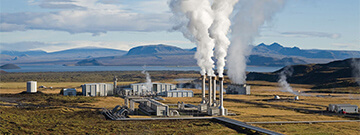
Energy from the Ground – Geothermal Energy!
It’s interesting to think that underneath us lies a powerful energy source. However, that’s exactly what geothermal energy is! Geothermal energy is simply the interior heat from the Earth. Geothermal energy is harnessed through hot water reservoirs that naturally exist or are created by humans at various temperatures and depths under the Earth’s surface. To access geothermal resources, wells up to a mile deep or more are sunk into subsurface reservoirs. The heat energy can power turbines that are linked to power generators, which can be used in a range of purposes such as power production, direct usage, and heating and cooling. The United States is the world’s greatest generator of geothermal energy, with most geothermal reservoirs located in the western states.
There are many ways that geothermal energy can be used. About 10 feet below the Earth’s surface, the ground is a steady temperature of 50 to 60° F all year. Geothermal heat pumps use this consistent temperature to heat or cool water. Water may be heated in the winter and cooled in the summer by traveling through the Earth. A heat exchanger can then use this water to heat or cool the air in a home. Another method of using the Earth’s heat is to directly use hot water from hot springs. This water may be utilized to heat houses and buildings using heat exchangers. It may also be used to heat pools.
Geothermal energy has several advantages. It may be extracted without the use of a fossil fuel like coal, gas, or oil. Geothermal resources emit around one-sixth of the carbon dioxide that a comparably clean natural-gas-fueled power plant does. Geothermal energy, unlike solar and wind energy, is always accessible. It’s also reasonably priced. However, it has certain environmental issues. The major source of worry is the emission of hydrogen sulfide, a gas that, even at low quantities, smells like rotten eggs. If present in high concentrations or with prolonged exposure, t is harmful to the respiratory and central nervous systems. Another issue to be concerned about is the disposal of some geothermal fluids, which may include trace amounts of harmful chemicals.
In today’s world, with a huge reliance on fossil fuels, geothermal energy may be a much better alternative to the harmful emissions, and it helps to power homes and businesses all over the world.
Source:
“Geothermal Energy Information and Facts.” ![]() Environment, National Geographic, 3 May 2021.
Environment, National Geographic, 3 May 2021.
Scientific Peer Review by Alysia Mandato
Aneri Shethji:
Aneri Shethji is a 10th grader at North Allegheny Intermediate High School. She is very passionate about science and writing and enjoys getting involved with the community. In her free time, Aneri spends time with friends and family and loves getting outside. She can’t wait to learn more about all that science has to offer, and help others learn it too!

On April 8, 2024, we will witness a mesmerizing event. A total solar eclipse is upon us, and here at the Science Center, we can explore this celestial phenomenon in many ways.
But first, what is this event? A ...

Climate change is a big deal. We’ve all seen news stories about greenhouse gas emissions, rising temperatures, and the hole in our ozone layer. However, what tends to sometimes be overlooked is climate change’s ...

In the captivating world of health care, a fascinating transformation is taking place—a rise in Artificial Intelligence, or AI! Picture a world where smart machines team up with doctors to revolutionize medicine, making ...

Hydroponics, a contemporary farming method, redefines how we grow plants, offering a fresh approach to cultivating crops that differs from traditional soil-based farming. This innovative technique doesn’t rely on soil ...

In our solar system, the eight planets—Mercury, Venus, Earth, Mars, Jupiter, Saturn, Uranus, and Neptune—are talked about more than anything. While the ...

Quantum computers are on the forefront of technological advancement. These machines, unlike any traditional computers you’re familiar with, harness the ...

The Earth is a spectacle of constant movement. Periodically, it commands our attention with displays of power—earthquakes. These events are tied to the intricate movements of the Earth's tectonic plates. Tectonic ...

Have you ever wondered how investigators in crime shows manage to identify suspects with such accuracy? Dusting for fingerprints isn’t always feasible in many cases, so the true answer lies in a different type of ...

Writers: Evan Allen, Ricardo Aguilar, Jillian Pensenstadler, Amelia Foley, and Ian Lisien
Once a center of industrial prowess, Pittsburgh has undergone a remarkable transformation, ...

Have you ever questioned what happens to the food you consume? Prepare yourself for a thrilling voyage as we go through your digestive system! We'll look at ...

When someone falls on their arm, they immediately head to the hospital to see if it is hurt. X-rays are used by doctors to examine your bones more ...

Even though dinosaurs became extinct about 65 million years ago, we know quite a bit about them, including what they ate, where they lived, and even what ...



